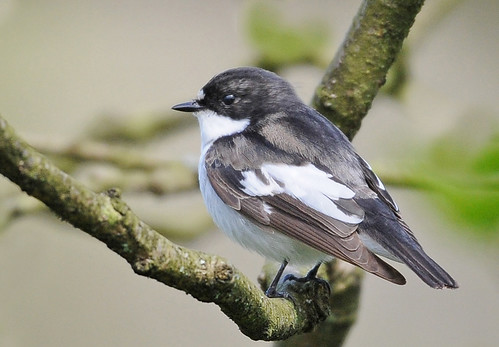I was up to Bowland yesterday morning, and down to the coast in the afternoon....What a truly brilliant area we live in, upland birding in the morning, and coastal birding 30 minutes later in the afternoon.
I was off to a good start yesterday and was at Marshaw by 8.15am and collected some nice rewards for the four hours I put in between Marshaw and Trough Bridge.
I was off to a good start yesterday and was at Marshaw by 8.15am and collected some nice rewards for the four hours I put in between Marshaw and Trough Bridge.
Spotted Flycatcher. Copy Permitted.
The bird in the image above was at Bank End today, and it was good to find 5 Spotted Flycatcher had found their way back to the Tower Lodge area again this year....I probably missed another five.
A singing male Pied Flycatcher was at Tower Lodge where I found two on 17 May, I've had no personal evidence of any females in the area. Also of note, a Cuckoo heard several times, 2 Redstart both singing males, 2 Common Sandpiper, 2 Dipper, 3 Treecreeper, 4 Mistle Thrush, 4 Willow Warbler, a male Siskin, and a healthy population of at least 12 Grey Wagtail including a young bird being fed.
At Conder Green where I visited nowhere beyond the viewing platform and saw the female Scaup, a distant Common Sandpiper surprised me, viewed from the west end of the pool and made me jump to attention for 2 seconds with the Temminck's Stint in mind, another surprise was a Little Ringed Plover, only my second sighting this year since my first two here on 2 April.
At Cockersands I had no time other than to check Plover Scar at high tide to count 455 Ringed Plover, and up to 100 Dunlin. I also checked Conder Pool and Cockersands today but little to add to yesterday with Plover Scar deserted to the extent that when a Peregrine Falcon flew over not a single wader came up off the scar. Nine Eider and a Whitethroat were to note.
Swallows.
Of particular note at Cockersands today was the continuing late passage of Swallows with some House Martin in the mix. I reckon the Swallows were passing and heading north at the rate of 100 per hour in the three hours I was there today. I see this at best as 'very late, and not good'.
Pied Flycatcher Paul Foster
A singing male Pied Flycatcher was at Tower Lodge where I found two on 17 May, I've had no personal evidence of any females in the area. Also of note, a Cuckoo heard several times, 2 Redstart both singing males, 2 Common Sandpiper, 2 Dipper, 3 Treecreeper, 4 Mistle Thrush, 4 Willow Warbler, a male Siskin, and a healthy population of at least 12 Grey Wagtail including a young bird being fed.
At Conder Green where I visited nowhere beyond the viewing platform and saw the female Scaup, a distant Common Sandpiper surprised me, viewed from the west end of the pool and made me jump to attention for 2 seconds with the Temminck's Stint in mind, another surprise was a Little Ringed Plover, only my second sighting this year since my first two here on 2 April.
At Cockersands I had no time other than to check Plover Scar at high tide to count 455 Ringed Plover, and up to 100 Dunlin. I also checked Conder Pool and Cockersands today but little to add to yesterday with Plover Scar deserted to the extent that when a Peregrine Falcon flew over not a single wader came up off the scar. Nine Eider and a Whitethroat were to note.
Swallows.
Swallow. Pete Woodruff.
Of particular note at Cockersands today was the continuing late passage of Swallows with some House Martin in the mix. I reckon the Swallows were passing and heading north at the rate of 100 per hour in the three hours I was there today. I see this at best as 'very late, and not good'.

























.jpg)









.jpg)







